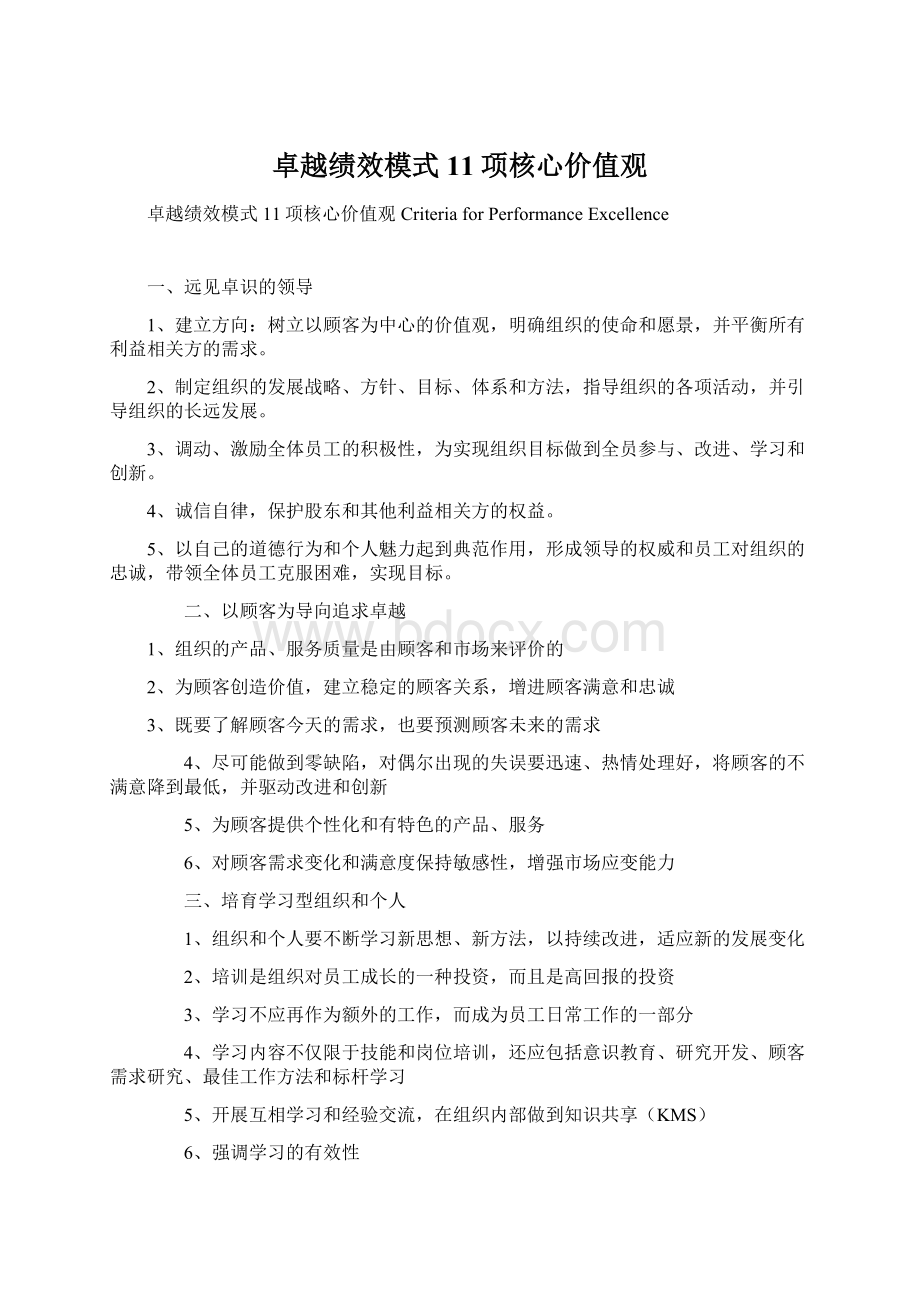卓越绩效模式11项核心价值观.docx
《卓越绩效模式11项核心价值观.docx》由会员分享,可在线阅读,更多相关《卓越绩效模式11项核心价值观.docx(10页珍藏版)》请在冰豆网上搜索。

卓越绩效模式11项核心价值观
卓越绩效模式11项核心价值观CriteriaforPerformanceExcellence
一、远见卓识的领导
1、建立方向:
树立以顾客为中心的价值观,明确组织的使命和愿景,并平衡所有利益相关方的需求。
2、制定组织的发展战略、方针、目标、体系和方法,指导组织的各项活动,并引导组织的长远发展。
3、调动、激励全体员工的积极性,为实现组织目标做到全员参与、改进、学习和创新。
4、诚信自律,保护股东和其他利益相关方的权益。
5、以自己的道德行为和个人魅力起到典范作用,形成领导的权威和员工对组织的忠诚,带领全体员工克服困难,实现目标。
二、以顾客为导向追求卓越
1、组织的产品、服务质量是由顾客和市场来评价的
2、为顾客创造价值,建立稳定的顾客关系,增进顾客满意和忠诚
3、既要了解顾客今天的需求,也要预测顾客未来的需求
4、尽可能做到零缺陷,对偶尔出现的失误要迅速、热情处理好,将顾客的不满意降到最低,并驱动改进和创新
5、为顾客提供个性化和有特色的产品、服务
6、对顾客需求变化和满意度保持敏感性,增强市场应变能力
三、培育学习型组织和个人
1、组织和个人要不断学习新思想、新方法,以持续改进,适应新的发展变化
2、培训是组织对员工成长的一种投资,而且是高回报的投资
3、学习不应再作为额外的工作,而成为员工日常工作的一部分
4、学习内容不仅限于技能和岗位培训,还应包括意识教育、研究开发、顾客需求研究、最佳工作方法和标杆学习
5、开展互相学习和经验交流,在组织内部做到知识共享(KMS)
6、强调学习的有效性
四、尊重员工和合作伙伴
1、在内部,要提高员工满意度:
对员工的承诺、保障与与工会的合作;创造公平竞争环境;对优秀员工的认可;为员工提供发展机会;在企业内做到知识共享,帮助员工实
现目标;营造一个鼓励员工迎接挑战的环境
2、在外部,与顾客、供应商、银行、社会团体等建立战略联盟与合作伙伴关系
3、建立战略合作伙伴关系的原则是:
实现互利和优势互补,增强双方实力和获利能力
4、成功的内部和外部合作伙伴关系应建立长远的战略目标,从制度和渠道上保证做到互相沟通,共同认识取得成功的关键要求
五、灵活性和快速反应
1、电子商务的出现缩短了贸易距离和时间
2、为了实现快速反应,要缩短产品更新周期和产品、服务的生产周期,精简机构和简化工作程序,实施同步工程和业务流程再造(BPR)
3、为了满足全球市场、顾客多样化需求,不能满足于简单的“按规定办事”、“按标准生产”,还要有更多的灵活性
4、培养掌握多种能力的员工更为重要,以便胜任工作岗位和任务变化的需要
5、时间将成为非常重要的指标,时间的改进会推动组织质量、成本和效率方面的改进
六、关注未来
1、持续增长和市场领先地位能给利益相关方以长期信心
2、要制定组织的发展战略,分析和预测影响组织发展的各种因素
3、根据组织确定的战略目标,制定中长期、短期计划,并配置所需的资源,保证战略目标的实现
4、为了追求组织持续、稳定的发展,要重视与员工和供应商的同步发展(联盟与合作)
七、创新的管理
1、创新是对产品、服务和过程的富有意义的变革,为组织带来新的绩效,为利益相关方创造新的价值
2、创新不仅仅局限于研究开发部门的技术和产品创新,管理创新也很重要。
管理创新包括:
思想观念、组织机构、运行机制和业务流程等多方面的创新
3、应领导和管理创新,使之融入到日常工作中,成为组织文化的一部分,促使全体员工积极地参与变革(危机意识),管理变革(风险管理),接受变革(能够容忍失败)
八、基于事实的管理
1、组织依赖于绩效的测量和分析
2、绩效测量指标应与组织的方向、战略保持一致(本身也要评价和改进),应反映顾客满意、运行过程和财务绩效情况并导致其改进
3、绩效测量所依据的数据和信息必须真实、可靠,应包括顾客、产品和服务的绩效;运作、市场和竞争绩效的对比,供应商、员工、成本和财务绩效
4、对数据、信息进行趋势、差距和因果分析,采取措施进行改进(PDCA)
5、分析支持多样性的用途:
策划、绩效评审、运作改进、变革管理、与竞争对手或标杆的绩效对比
九、社会责任与公民义务
1、组织的领导应对社会负有责任,尽好公民义务
2、公共责任要求组织遵守职业道德,保护公共健康、安全和环境,节约资源和预防污染
3、应从产品设计开始就考虑到环境、资源和安全等方面的要求
4、不能仅满足于法规要求,应注重持续改进、超越标准
5、公民义务是指在资源许可条件下,积极从事公益事业,在社会活动中起到引导和支持作用(取之于民、用之于民)
十、重在结果与创造价值
1、经营结果是评价组织绩效的重点
2、要为利益相关方(顾客、股东、员工、供应商和社会)创造平衡的价值,处理好短期、长期目标的关系
3、经营结果不限于销售额和利润,包括:
以顾客为中心的结果、产品和服务结果、财务和市场结果、人力资源结果、组织有效性结果、组织自律和社会责任结果
4、“结果”应是有“因”之果,是“方法-展开”的结果;“方法-展开”的成熟度如何要看“结果”;“方法-展开”的改进应以“结果”为导向
十一、系统的观点
1、卓越绩效模式:
以系统的思维来管理整个组织,取得卓越绩效。
2、系统=综合、一致、整合:
----综合意味着把组织看成一个整体,建立于关键的经营要求,包括战略目标和行动计划(整体)
----一致意味着标准要求,确保计划、过程、测量和措施的一致性(纵向)
----整合意味着绩效管理体系中的各独立部分以充分相连的方法运作(横向)
3、系统的观点在质量奖标准的框架图中得到描述,包括:
----高层领导重视战略方向和顾客,基于经营结果来监视、因应和管理绩效
----运用测量指标,将关键战略、关键过程相,并与资源配置一致,以改进整体绩效,使顾客满意。
核心价值观原文,摘自2006BusinessCriteria.
CoreValuesandConcepts
TheCriteriaarebuiltonthefollowingsetofinterrelatedCoreValuesandConcepts:
i._Visionaryleadership
ii._customer-drivenexcellence
iii._organizationalandpersonallearning
iv._valuingemployeesandpartners
v._agility
vi._focusonthefuture
vii._managingforinnovation
viii._managementbyfact
ix._socialresponsibility
x._focusonresultsandcreatingvalue
xi._systemsperspective
Thesevaluesandconcepts,describedbelow,areembeddedbeliefsandbehaviorsfoundinhigh-performingorganizations.Theyarethefoundationforintegratingkeyperformanceandoperationalrequirementswithinaresults-orientedframeworkthatcreatesabasisforactionandfeedback.
VisionaryLeadership
Yourorganization’sseniorleadersshouldsetdirectionsandcreateacustomerfocus,clearandvisiblevalues,andhighexpectations.Thedirections,values,andexpectationsshouldbalancetheneedsofallyourstakeholders.Yourleaders
shouldensurethecreationofstrategies,systems,andmethodsforachievingperformanceexcellence,stimulatinginnovation,buildingknowledgeandcapabilities,andensuringorganizationalsustainability.Thevaluesandstrategiesshouldhelpguideallofyourorganization’sactivitiesanddecisions.Seniorleadersshouldinspireandmotivateyourentireworkforceandshouldencourageallemployees,includinganyvolunteers,
tocontribute,todevelopandlearn,tobeinnovative,andtobecreative.Seniorleadersshouldberesponsibletoyourorganization’sgovernancebodyfortheiractionsand
performance.Thegovernancebodyshouldberesponsibleultimatelytoallyourstakeholdersfortheethics,actions,andperformanceofyourorganizationanditsseniorleaders.Seniorleadersshouldserveasrolemodelsthroughtheirethicalbehaviorandtheirpersonalinvolvementinplanning,communications,coaching,developmentoffutureleaders,reviewoforganizationalperformance,andemployeerecognition.Asrolemodels,theycanreinforceethics,values,andexpectationswhilebuildingleadership,commitment,andinitiativethroughoutyourorganization.
Customer-DrivenExcellence
Qualityandperformancearejudgedbyanorganization’scustomers.Thus,yourorganizationmusttakeintoaccountallproductandservicefeaturesandcharacteristicsandallmodesofcustomeraccessthatcontributevaluetoyourcustomers.Suchbehaviorleadstocustomeracquisition,satisfaction,preference,referral,retentionandloyalty,andtobusinessexpansion.Customer-drivenexcellencehasbothcurrentandfuturecomponents:
understandingtoday’scustomerdesiresandanticipatingfuturecustomerdesiresandmarketplacepotential.Valueandsatisfactionmaybeinfluencedbymanyfactorsthroughoutyourcustomers’overallexperiencewithyourorganization.Thesefactorsincludeyourorganization’scustomerrelationships,whichhelptobuildtrust,confidence,andloyalty.Customer-drivenexcellencemeansmuchmorethanreducing
defectsanderrors,merelymeetingspecifications,orreducingcomplaints.Nevertheless,thesefactorscontributetoyourcustomers’viewofyourorganizationandthusalso
areimportantpartsofcustomer-drivenexcellence.Inaddition,yourorganization’ssuccessinrecoveringfromdefects,serviceerrors,andmistakesiscrucialtoretainingcustomersandbuildingcustomerrelationships.Customer-drivenorganizationsaddressnotonlytheproductandservicecharacteristicsthatmeetbasiccustomerrequirementsbutalsothosefeaturesandcharacteristicsthatdifferentiateproductsandservicesfromcompetingofferings.Suchdifferentiationmaybebasedonnewormodified
offerings,combinationsofproductandserviceofferings,customizationofofferings,multipleaccessmechanisms,rapidresponse,orspecialrelationships.Customer-drivenexcellenceisthusastrategicconcept.Itisdirectedtowardcustomerretentionandloyalty,marketsharegain,andgrowth.Itdemandsconstantsensitivitytochangingandemergingcustomerandmarketrequirementsandtothefactorsthatdrivecustomersatisfactionandloyalty.Itdemandslisteningtoyourcustomers.Itdemandsanticipating
changesinthemarketplace.Therefore,customerdrivenexcellencedemandsawarenessofdevelopmentsintechnologyandcompetitors’offerings,aswellasrapidand
flexibleresponsestocustomer,environmental,andmarketchanges.
OrganizationalandPersonalLearning
Achievingthehighestlevelsoforganizationalperformancerequiresawell-executedapproachtoorganizationalandpersonallearning.Organizationallearningincludesboth
continuousimprovementofexistingapproachesandsignificantchange,leadingtonewgoalsandapproaches.Learningneedstobeembeddedinthewayyourorganizationoperates.Thismeansthatlearning
(1)isaregularpartofdailywork;
(2)ispracticedatpersonal,workunit,andorganizationallevels;(3)resultsinsolvingproblemsattheirsource(“rootcause”);(4)isfocusedonbuildingandsharingknowledge
throughoutyourorganization;and(5)isdrivenbyopportunitiestoeffectsignificant,meaningfulchange.Sourcesforlearningincludeemployees’andvolunteers’ideas,researchanddevelopment(R&D),customers’input,bestpracticesharing,andbenchmarking.Organizationallearningcanresultin
(1)enhancingvalueto
customersthroughnewandimprovedproductsandservices;
(2)developingnewbusinessopportunities;(3)reducingerrors,defects,waste,andrelatedcosts;(4)improvingresponsivenessandcycletimeperformance;(5)increasingproductivityand
effectivenessintheuseofallyourresources;and(6)enhancingyourorganization’sperformanceinfulfillingitssocietalresponsibilitiesanditsservicetoyourcommunity.Employees’successdependsincreasinglyonhavingopportunities
forpersonallearningandonpracticingnewskills.Inorganizationsthatrelyonvolunteers,thevolunteers’personallearningalsoisimportant,andtheirlearningandskilldevelopmentshouldbeconsideredwithemployees’.Organizationsinvestinemployees’personallearningthrougheducation,training,andotheropportunitiesforcontinuinggrowthanddevelopment.Suchopportunitiesmightincludejobrotationandincreasedpayfordemonstratedknowledgeandskills.On-the-jobtrainingoffersacost-effectivewaytotrainandtobetterlinktrainingtoyourorganizationalneeds
andpriorities.Educationandtrainingprogramsmaybenefitfromadvancedtechnologies,suchascomputer-andInternetbasedlearningandsatellitebroadcasts.Personallearningcanresultin
(1)moresatisfiedandversatileemployeeswhostaywithyourorganization,
(2)organizationalcross-functionallearning,(3)thebuildingofyourorganization’sknowledgeassets,and(4)animprovedenvironmentforinnovation.Thus,learningisdirectednotonlytowardbetterproductsandservicesbutalsotowardbeingmoreresponsive,adaptive,innovative,andefficient—givingyourorganizationmarketplace
sustainabilityandperformanceadvantagesandgivingyouremployeessatisfactionandmotivationtoexcel.
ValuingEmployeesandPartners
Anorganization’ssuccessdependsincreasinglyonthediversebackgrounds,knowledge,skills,cr